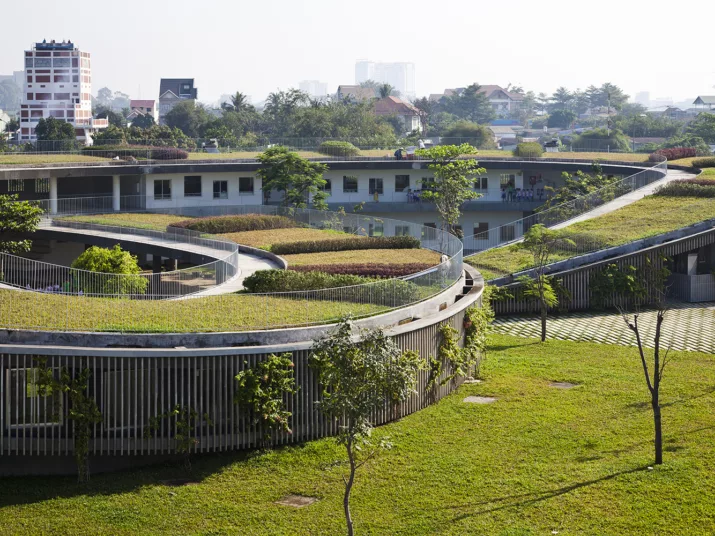
Photo: Hiroyuki Oki
THINKING SPACE NATURE
ECO-FASHION FOR CITIES: FIVE REASONS FOR GREENING THE FACADES OF BUILDINGS
Sträucher wuchern vertikal an Fassaden, Bäume wachsen auf Dächern. Für die einen ist Gebäudebegrünung ein botanisches Wunder. Für die anderen urbane Kunst. Fünf Gründe, warum sie immer ein Gewinn ist.

Photo: Hiroyuki Oki
1) RENEWABLE HELP FOR THE CLIMATE
In the Anthropocene –the geological era in which we live that is defined by human impact upon the world – nature is making way for expanding cities, and this has become a problem for the climate. In the European Union, for example, the construction of buildings, as well as their heating and cooling, already accounts for more than one third of total energy consumption. If, in the future, buildings were to be wrapped in green clothing, the cost of air conditioning would decrease. After all, more energy is consumed around the globe for cooling on hot days than for heating on cold.
2) HEALTHY URBAN LIFE
Bye-bye to smog warnings? That’s certainly possible if we add more nature to façades and roofs. Because plants filter pollutants and fine dust from the air. The latter will become cleaner – and city dwellers will be able to breathe better. Insects and birds will profit too: they’ll be able to move in wherever new habitats sprout up on greened buildings.
3) HERE’S TO A GOOD PARTNERSHIP: SHRUBS AND SOLAR
On many a roof of the future, covered by partially transparent solar panels, blades of grass and succulent plants that store water in their leaves will be reaching up towards the light. Greened buildings and solar power systems are ideal partners. Unlike gravel or concrete, greened roofs reduce the ambient temperature because they vaporise water. In this way, they increase the efficiency of photovoltaic systems.
4) IN THE SHADE OF THE CITY FOREST
The summer sun is giving its all – and many city dwellers feel like they’re trapped in a huge oven. For now, that is. If greened façades were to become part of everyday urban life, the city would cool down because greenery provides shade. And the higher the temperatures, the more water evaporates from the plants, cooling buildings and the environment. During the cold season, the climbing plants lose their leaves and let the sun’s rays shine on the building and through windows.
5) THE BEAUTY OF GREEN LIVING
The façades of many buildings have long been conquered by climbing and creeping plants – from vines to ivy. In the future, architects and urban planners could integrate into the earliest stages of their designs climbing structures for plants. Because wall plants are perfectly suited to act as natural sun blockers for windows and interior spaces. And they needn’t be on the scale of Milan’s famous “vertical forest”, the Bosco Verticale: even smaller-scale greenery on façades enhances the city’s architectural look and reduces the urban background noise. It also serves as a way of retaining rainwater in cities and thereby helping to prevent flooding.
DO IT YOURSELF
Do you fancy greening your balcony like a professional gardener? A step-by-step guide to your own little garden full of pot plants: https://www.nabu.de/umwelt-und-ressourcen/oekologisch-leben/balkon-und-garten/grundlagen/elemente/22318.html
How can you make your balcony bird-friendly? Find out here: https://www.nabu.de/umwelt-und-ressourcen/oekologisch-leben/balkon-und-garten/trends-service/diy-rezepte/26388.html
READ MORE
Pfoser, N. et al: Gebäude, Begrünung und Energie: Potenziale und Wechselwirkungen. Darmstadt 2013